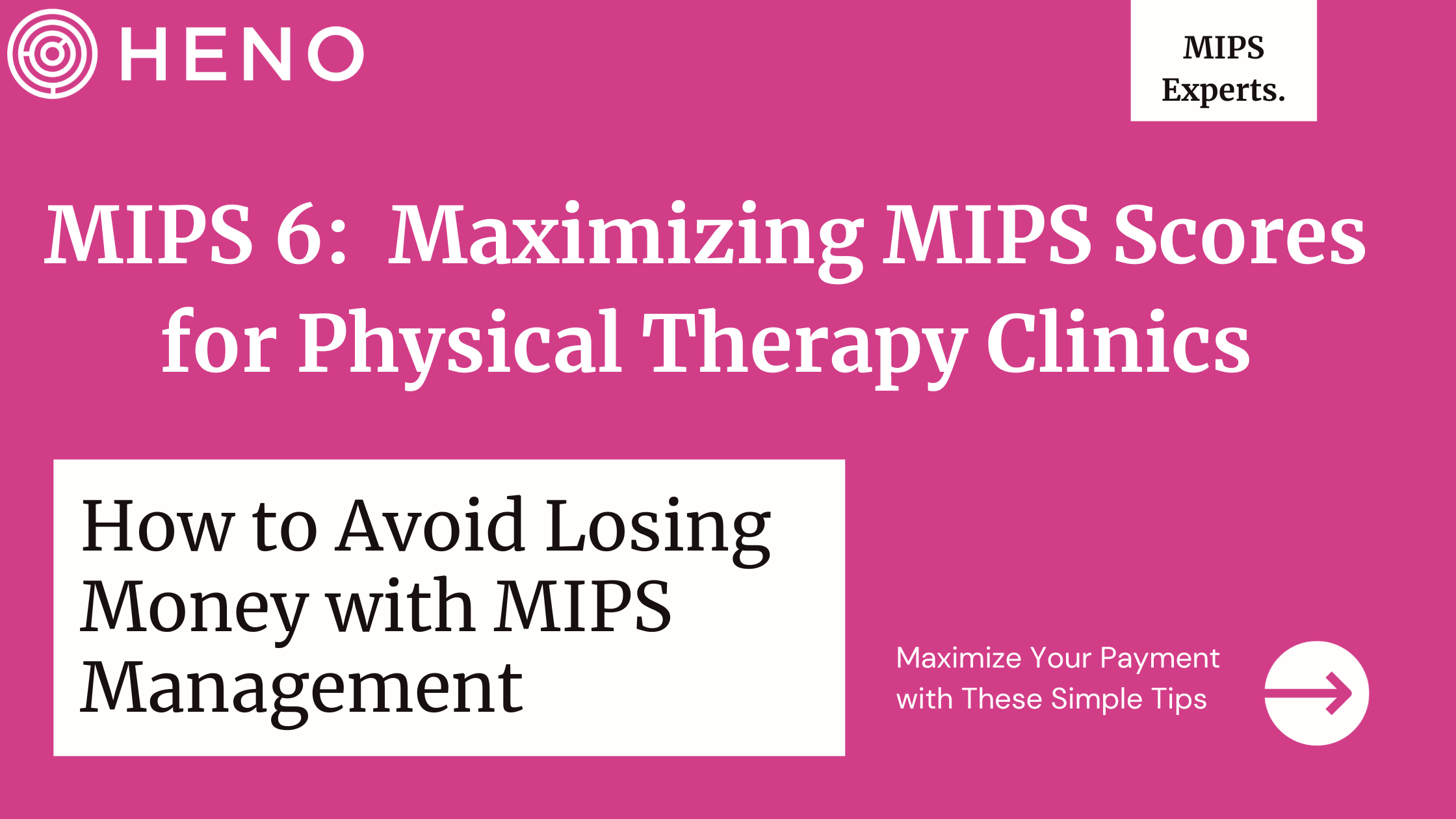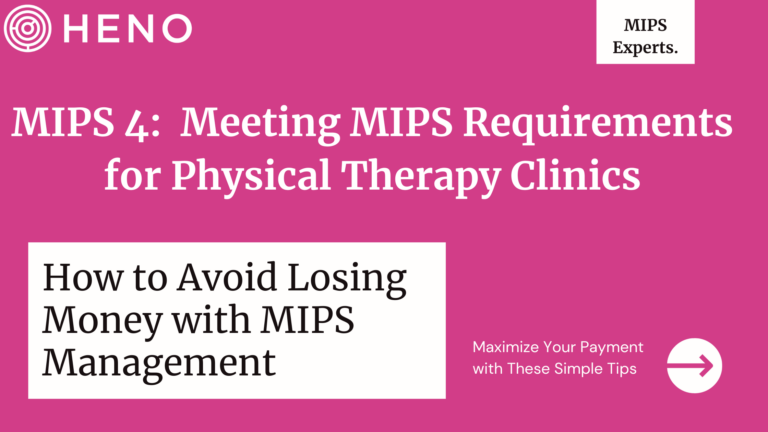MIPS 6: Maximizing MIPS Scores for Physical Therapy Clinics

In this article we’ll explore Maximizing MIPS Scores for Physical Therapy Clinics. If you haven’t already read the first 3 articles in this series, you can click the following to read them, and if you need the MIPS Quick start guide from Medicare you can get that here.
Strategies to Improve Quality Performance
In the ever-evolving landscape of healthcare, quality performance is of utmost importance for Physical Therapy Clinic Owners. As clinics prepare to navigate the requirements of the Merit-based Incentive Payment System (MIPS), it becomes crucial to implement strategies that enhance quality performance and ensure maximum reimbursement.
1. Implement Clinical Decision Support Systems: Integrating clinical decision support systems into your practice can significantly improve quality performance. These systems provide real-time guidance to clinicians, helping them make evidence-based decisions, reduce errors, and enhance patient outcomes. By utilizing these systems, Physical Therapy Clinic Owners can demonstrate their commitment to delivering high-quality care.
2. Foster a Culture of Continuous Learning: Encouraging a culture of continuous learning among your staff is essential for improving quality performance. Provide opportunities for professional development, such as attending conferences, workshops, and webinars. Encourage staff members to stay updated with the latest research and advancements in physical therapy. By investing in ongoing education, you can equip your team with the knowledge and skills necessary to deliver exceptional care.
3. Embrace Technology: Incorporating technology into your clinic’s operations can streamline processes, improve efficiency, and enhance quality performance. Electronic health records (EHRs) can help track patient outcomes, identify areas for improvement, and monitor compliance with MIPS requirements. Telehealth services can also be utilized to expand access to care and improve patient satisfaction. Embracing technology enables Physical Therapy Clinic Owners to adapt to the evolving healthcare landscape and deliver high-quality care in a patient-centered manner.
4. Engage Patients in Their Care: Engaging patients in their care is a crucial aspect of quality performance. Empower patients by providing them with educational resources, involving them in shared decision-making, and encouraging active participation in their treatment plans. Utilize patient satisfaction surveys to gather feedback and continuously improve the patient experience. By prioritizing patient engagement, Physical Therapy Clinic Owners can enhance quality performance and achieve better outcomes.
5. Collaborate with Peers: Collaborating with other physical therapy clinic owners and professionals can provide valuable insights and support in improving quality performance. Join professional organizations, attend networking events, and participate in peer-to-peer learning opportunities. Sharing best practices, discussing challenges, and seeking advice from industry experts can help Physical Therapy Clinic Owners stay ahead of the curve and continuously improve their clinic’s quality performance.
In conclusion, improving quality performance is crucial for Physical Therapy Clinic Owners as they navigate the requirements of MIPS. By implementing strategies such as clinical decision support systems, fostering a culture of continuous learning, embracing technology, engaging patients, and collaborating with peers, clinic owners can enhance quality performance, deliver exceptional care, and maximize reimbursement under MIPS.

Enhancing Promoting Interoperability Measures
In this subchapter, we will discuss the importance of enhancing promoting interoperability measures for physical therapy clinics participating in the Merit-based Incentive Payment System (MIPS). As a physical therapy clinic owner, understanding the intricacies of MIPS for your specific niche is crucial to optimizing your clinic’s performance and maximizing reimbursement. It’s critical to understand how interoperability fits into maximizing MIPS Scores for Physical Therapy Clinics
Promoting interoperability refers to the ability of different healthcare systems and software to seamlessly exchange and utilize patient data. For physical therapy clinics, this means ensuring that your electronic health record (EHR) system is capable of securely sharing patient information with other healthcare providers and systems, such as hospitals, primary care physicians, and other specialists.
Why is enhancing promoting interoperability measures important for physical therapy clinics under MIPS? Firstly, it allows for better coordination of care. By having access to a patient’s complete medical history, including relevant data from other providers, physical therapists can make more informed decisions and provide more personalized treatment plans. This ultimately improves patient outcomes and satisfaction.
Secondly, interoperability plays a significant role in reducing administrative burden. When your EHR system seamlessly integrates with other healthcare systems, it eliminates the need for manual data entry or faxing of patient information. This streamlines workflows, saves time, and reduces the risk of errors.
To enhance promoting interoperability measures, physical therapy clinic owners should consider a few key strategies. Firstly, ensure that your EHR system meets the requirements for interoperability set by the Centers for Medicare and Medicaid Services (CMS). This may involve working with your EHR vendor to implement necessary upgrades or improvements.
Secondly, establish secure and efficient data exchange protocols with other healthcare providers in your network. This can be achieved through Health Information Exchanges (HIEs) or participating in regional health information organizations (RHIOs). These collaborations enable the seamless sharing of patient data while adhering to strict privacy and security standards.
Lastly, train your staff on the importance of promoting interoperability and how to effectively utilize your EHR system for data exchange. This includes educating them on privacy and security protocols to ensure compliance with HIPAA regulations.
In conclusion, enhancing promoting interoperability measures is crucial for physical therapy clinics participating in MIPS that are interested in maximizing MIPS Scores for Physical Therapy Clinics. By optimizing your EHR system and establishing effective data exchange protocols, you can improve care coordination, reduce administrative burden, and ultimately enhance the overall quality of care provided by your clinic.
Implementing Effective Improvement Activities
As a physical therapy clinic owner, it is crucial to stay updated with industry regulations and requirements to ensure your clinic’s success. One such requirement is the Merit-Based Incentive Payment System (MIPS) for physical therapy clinics. MIPS is a program developed by the Centers for Medicare and Medicaid Services (CMS) that aims to promote high-quality healthcare services and improve patient outcomes.
To maximize your clinic’s performance under MIPS, it is essential to implement effective improvement activities. These activities not only help you meet MIPS requirements but also contribute to enhancing the quality of care provided to your patients. In this subchapter, we will explore practical strategies for implementing these improvement activities in your physical therapy clinic.
First and foremost, it is crucial to assess your clinic’s current practices and identify areas that require improvement. This can be achieved through regular self-audits and feedback from your staff and patients. By understanding the specific areas that need attention, you can tailor improvement activities to address those needs effectively.
One effective improvement activity is the implementation of evidence-based practices. By incorporating the latest research and clinical guidelines into your treatment protocols, you can ensure that your clinic is providing the best possible care to your patients. This may involve staff training, updating clinical policies, and monitoring adherence to these evidence-based practices.
Another important aspect of effective improvement activities is the use of health information technology (HIT). MIPS places significant emphasis on the use of electronic health records (EHRs) and interoperability. By adopting an EHR system that is MIPS-compliant, you can streamline data collection, reporting, and analysis. Additionally, utilizing HIT tools such as clinical decision support systems can help improve clinical decision-making and patient outcomes.
Furthermore, engaging your staff in quality improvement initiatives is vital for success. Encourage a culture of continuous learning and improvement by providing regular training sessions, workshops, and opportunities for professional development. Engaged and knowledgeable staff members are more likely to actively participate in improvement activities and contribute to positive patient outcomes.
Lastly, monitoring and evaluating the effectiveness of your improvement activities is crucial. Establish metrics and benchmarks to measure progress and track changes over time. Regularly review the data collected and make necessary adjustments to your improvement activities based on the results.
In conclusion, implementing effective improvement activities is essential for physical therapy clinic owners looking to succeed under MIPS. By assessing your clinic’s needs, incorporating evidence-based practices, utilizing health information technology, engaging your staff, and monitoring progress, you can ensure that your clinic provides high-quality care while meeting MIPS requirements. Stay proactive in your improvement efforts, and you will not only thrive under MIPS but also improve patient outcomes and satisfaction.
Cost Optimization Techniques
Maximizing MIPS Scores for Physical Therapy Clinics is critical in today’s competitive healthcare industry because physical therapy clinic owners are constantly seeking ways to maximize revenue while minimizing costs. One effective strategy to achieve this is through cost optimization techniques in the context of the Merit-based Incentive Payment System (MIPS) for physical therapy clinics. By implementing these techniques, clinic owners can improve their financial performance, enhance patient care, and ensure long-term sustainability.
1. Staff Utilization: Optimizing staff utilization is crucial for cost reduction. By analyzing patient demand patterns, clinic owners can determine the appropriate number of therapists and support staff needed at any given time. This prevents overstaffing, reduces labor costs, and ensures optimal patient care.
2. Technology Integration: Embracing technology can significantly enhance cost optimization efforts. Implementing an electronic health record (EHR) system, for example, can streamline administrative tasks, reduce paperwork, and improve accuracy. Additionally, telehealth services can be utilized to reach patients in remote areas, reducing travel expenses for both patients and therapists.
3. Supply Chain Management: Efficient management of the supply chain is essential for cost optimization. Clinics should negotiate favorable contracts with suppliers, stock essential items in bulk, and regularly review inventory levels to minimize waste and prevent overstocking.
4. Preventive Maintenance: Regular preventive maintenance of equipment and facilities can help avoid costly repairs and downtime. By implementing a proactive maintenance schedule, clinic owners can extend the lifespan of their assets, reduce repair expenses, and ensure smooth operations.
5. Financial Analysis: Conducting regular financial analysis is crucial for identifying areas of inefficiency and cost-saving opportunities. This includes tracking key performance indicators (KPIs) such as revenue per patient, average treatment duration, and cost per visit. By monitoring these metrics, clinic owners can make informed decisions to optimize costs and improve profitability.
6. Marketing Strategies: Effective marketing strategies can attract a steady stream of new patients, reducing the need for costly advertising campaigns. Clinic owners should focus on building strong relationships with referring physicians, leveraging online platforms, and implementing referral incentives to generate a consistent patient flow.
By implementing these cost optimization techniques, physical therapy clinic owners can improve their financial performance, provide high-quality care to patients, and stay competitive in the ever-evolving healthcare landscape. MIPS for physical therapy clinics provides a framework for incentivizing and rewarding efficient and effective care delivery, and by integrating these techniques, clinic owners can successfully navigate the complexities of MIPS while optimizing costs and achieving sustainable growth.





